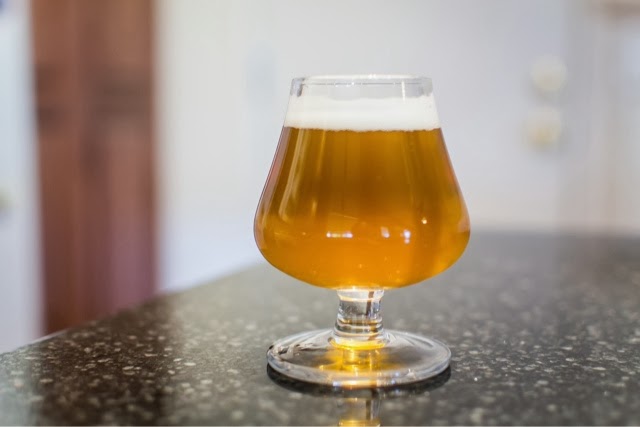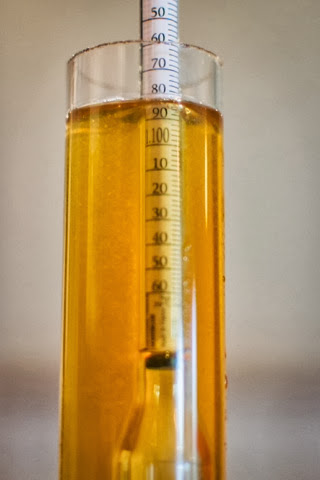Wedding Batch #3: Enjoy By 09.28.13

The last of the three wedding beers is one I’ve brewed a couple times before. I love big hoppy IPAs, and I knew everyone at the wedding would be expecting an amazing IPA on tap. After brewing an Enjoy By Clone a few months ago, it was an easy decision to brew that recipe for the wedding.
I took another stab at the recipe last month. For that batch I decided to see how the recipe fared with an American yeast, and it turned out fantastic. So with plenty of confidence in the recipe, I finally got around to brewing this beer about 4 weeks before the wedding. Kiernan is again splitting this batch with me, so it’s a 10 gallon batch. Once I started adding up the numbers, it was clear this is the biggest recipe I’ve ever brewed. The most grain, and without-a-doubt the most hops. On the bright side, I learned my mash tun can fit 33lbs of grain with a fair amount of room to spare =)
As for actually brewing this beer, it was pretty straight forward. I did a 75min mash at 147* before running out and sparging. The mash hops make this beer lauter a little slower than usual, but it’s not too bad. After I had all the wort in the kettle, we boiled it for 90 minutes, then whirlpooled for 20 minutes before chilling to 62F. Chilling took some time, but we ended up with two full fermenters at 1.082 (The hydrometer photo had been in the fridge for awhile before I took the photo).
Brewed: 09-02-13
Dry Hopped: 09-11-13
Kegged: 09-17-13
OG: 1.082
FG: 1.010
ABV: 9.45%
IBU: 90
12 Gallons
16.5lbs English Pale Malt (3.5L)
16.5lbs 2-row
2lb Dextrose
Mash at 147* for 75min
4oz Belma (Calypso) – Mash Hopped
2.4oz Apollo @ 90
2oz ea. Simcoe, Belma (Delta), Northern Brewer(Target), Amarillo @ 15
2.5oz ea. Citra, Cascade, Centennial (Motueka) @ Flameout
Whirlpool for 20min
WLP090 – Super San Diego Yeast
Dry Hop 1: 3oz ea Nelson Sauvin & Galaxy
Dry Hop 2: 3oz ea Nelson Sauvin & Galaxy
Both fermenters got a healthy dose of O2 before pitching the yeast. For one fermenter, I re-pitched WLP090 from the Cali Common, and the other I pitched a 3L starer of 090 to see if there was any difference. They both fermented nearly identically, and hit the same terminal gravity in about 5 days. Due to a mixture of being busy and lazy, it was a good 9 days before I racked this beer to thoroughly CO2-purged kegs for dry hopping. Six days later, with just enough time to carb before the wedding, I racked the beer to keg, and stuck it on gas.
 I never really had a chance to try this beer before the wedding, other than a hydrometer sample that tasted amazing. So when we pulled the first pint on Saturday night after the nuptials, I was smiling ear-to-ear. It turned out incredible — probably the best single batch of beer I’ve brewed. I’m not sure if it was the copious gassing of the kegs before racking, or just the overall attention to detail, but this beer rocked.
I never really had a chance to try this beer before the wedding, other than a hydrometer sample that tasted amazing. So when we pulled the first pint on Saturday night after the nuptials, I was smiling ear-to-ear. It turned out incredible — probably the best single batch of beer I’ve brewed. I’m not sure if it was the copious gassing of the kegs before racking, or just the overall attention to detail, but this beer rocked.
This is the biggest and boldest hop aroma I’ve ever achieved in an IPA. It was fruity, citrusy, and sweet in the nose. Nelson gives off a bit of a dank aroma, but it’s not nearly as strong as the tropical fruit character. The flavor started off with big complex hops, followed by smooth bitterness, and a hint of alcohol. The alcohol note was present, but not too strong. Almost no one guessed the beer was 9.4-9.5% ABV.
This beer was unquestionably the superstar at the wedding. Everyone had nothing but praise for it, and the keg kicked about 2 hours into the reception. Our friends and family that don’t normally drink IPAs liked it a lot. Our friends and family that do like IPAs, absolutely loved this beer. It was probably a little to blame for everyone being a bit tipsy by the end of the night, but hey, that’s just collateral damage. =)





Wow! this looks awesome, and congratulations again Scott! Do you know another substitute for belma or delta btw? that is the single hop that seems to be troublesome for me to aquire…
Are you using the in keg dry hopper from stainless brewing? I am having issues with really small hop particulate still being in the final beer. I even fined with gelatin this last batch and I still have some hanging around. My only guess is that I am not getting the beer cold enough.
Thoughts?
Chris
I do use it, but I didn't mess with it on this batch. I just tossed the pellets loose into the keg. I've also found it lets a tiny amount of hop particulate through, but my beers still seem to clear up after a couple pints :shrug:
G'day Scott, since you have such great results with kegging IPA's (a notoriously difficult process), have you ever considered (or would you consider) writing up a quick post on your kegging technique? You say things like "copious gassing of the kegs before racking" but what exactly does that entail? It seems like whenever I keg an IPA, the hop aroma fades very quickly.
Also, when you say "3L starter of 090" do you have a particular cell count target in mind? Or is it just your experience that a 3L starter is what is required to ferment 6 gallons of high gravity ale? Do you have a "trick" to figuring out the necessary starter size?
I use the mr malty calculator, it's free online. It should give you a target cell count for the OG of your beer and viability of your yeast.
The article on kegging is actually a really good idea; I'll put that on my to-do list.
As for the starters and yeast pitch rates. Yes, I'm usually targeting a specific pitch count. I use Mr. Malty's pitch rate calculator, but I do find his estimates to be a bit too conservative at times. I use a stir plate, so I mostly just plug my numbers into his site and see what I get. For big IPAs, (1.070 and up), it usually works out to about a 3L starter for me.
I think an article on that would be great. I am interested in your process for things like racking into the keg (do you setup a ball lock connector at the end of the racking cane to rack through the dip tube? Is it worth it to setup a keg -> keg system for transferring using CO2 and two ball lock connectors?), and things like doing multiple hop editions in the stainless brewing dry hopper.
The other process I am interested in is what your process is for blasting the secondary with CO2, as well as your racking procedure in general (is the autosiphon injecting too much oxygen and I should just use a plain racking cane?)
kind of suprised you went with mash hops with this, don't think you did this before. i am kind of sceptical about the whole mash hops thing. do you really think it makes a difference? thanx!
duh skeptical
How do the bittering qualities of Apollo compare to CTZ? I know it's a descendant of Zeus, and I've always found the bitterness from CTZ a little too harsh for me. I prefer Magnum or Horizon for their clean bitterness, but I love the aroma of fresh, high quality CTZ. Have you used Apollo as an aroma hop?
I really don't feel they make a difference, but
A. I didn't want to change anything on a batch right before the wedding.
B. I really need to use up these Belma hops I have, and mash hops seemed like a great place to 'waste' them.
A little less harsh than CTZ, Apollo is even more pungent and dank than CTZ; less citrus in the aroma though. It's very oily.
For a bittering hop, it's fantastic. It stores better than most hops (loses less AA% as it ages), and it's super high in AA to start with.
Give it, or Bravo a shot. They're both really good new-school bittering hops.;
I also would love to see a write up on both your dry hoping and kegging procedures for hoppy beers. I just finished a completely oxidized Two Hearted clone and I'm a little gunshy on brewing up another IPA now.
Ya, I feel your pain. Been there. Done that.
I'll get an article posted here in about 2-3 weeks. I'm brewing an IPA this weekend, so I'll take some photos during the dry hopping and kegging process in the weeks to follow.
So does the fact that you used Apollo @ 90 for bittering mean you've given up using hop extracts if you can avoid it? 😉 I brewed your Pliny the Younger a couple of months ago with 16 Hop Shots in it (40ml per 6 gallons), and man, what a sticky tar-like mess that was to clean up. A normally 5-10 minute boil kettle cleaning took over an hour and 2/3 bottle of Oxiclean spray. I don't think I'd bother with hop extracts with a recipe like this either! Speaking of which: In your two previous "Enjoy By" clones where you used 10ml of hop extract per 6 gallons. Was that somewhat easier to clean than your Pliny the Younger (40ml per 6 gallons) and Pliny the Elder (30ml per 6 gallons)?
Cheers,
Kal, TheElectricBrewery.com
I was just out of hop extract, and completely forgot to order more online (it's not available here locally.) I agree, hop extract in any decent quantity leaves such a mess inside the kettle.
I would say the previous two batches that used extract were still hard to clean, but not quite the magnitude of the Pliny batches.
For this recipe, the difference was indistinguishable. I won't lie, I'm not questioning how much of a difference hop extract makes in these massive IPAs. I'm really tempted to brew either of the Pliny recipes with Apollo, and see what it turns out like. I'm not sold on hop extract, but I'm not sold against it either. I'm going to need to experiment a little more before I make up my mind.
By the way, how did the Younger recipe turn out?
*now questioning
The Younger turned out absolutely phenomenal! It's been on tap now for about 3 weeks. Finished reasonably dry (1.008) which is what I wanted. I don't like overly sweet double IPAs/IIPAs myself so I did all I could to go from 1.088 -> 1.008 or lower, including step mash (somewhat like Bud Light) where I held at 145F for 90 mins then ramped up to 155F and held for another 30 before mashing out. I wanted this thing to finish as dry as possible with the Chico (US-05) yeast I used. If you're curious, I did a write-up on it (and gave you props for the recipe since it's basically yours). See: http://www.theelectricbrewery.com/forum/viewtopic.php?t=26749
That's pretty awesome! Nice work. That's a beautiful bar you have there by the way.
When you say English Pale Malt, is that Marris Otter?
Scott,
How do you account for the hop particulate that shows up in the beer during secondary? I use the same dry hopper, and actually brewed this recipe before I found your blog… I gelatin, cold crash for a week. Beer is crystal clear, but if I have to move the keg (take one to a party) there's always so much junk stirred up in the beer… my version varies a little from your's but this may be the best ipa Ive ever tasted. Would love to know if you face the same issues with hop sludge. I'm switching to biofine clear, going to transfer from secondary to final keg ontop of biofine via co2 and jumper line, pour out 1-2 pints prior to transfer. Hoping that helps. Also thinking about putting hop additions into muslin bag, and dropping into steel dry hopper. Cheers. You have a great blog. Come down to Jax FL, and let's brew!!!
I deal with it much like you do. Another alternative would be to crash the beer prior to pulling out the dry hopper, or rack out of the keg into a fresh keg.
For the wedding we just gave the kegs a few hours to settle, it seemed to do the trick.
Scott –
I'm a fairly new all grain brewer who likes to swing for the fences out of the gates with recipes like this. I'm doing 5 gallon batches with about 17.5 lbs of grain and get hit the target OG's. I've been coming up way short. Any recommendations? I've been mashing pretty steady at about 151.
love your recipes. I'm going to try several of them the next few months. also, congrats on the nuptials!
Thanks!
There's a number of things that can affect mash efficiency, with sparging techniques being the biggest. If you fly sparge, make sure you are sparging very slow. If you batch sparge, make sure you are stirring in the water additions like crazy.
Those would be the first things I could check.
I've been fly sparging and the last one I did for about 80 minutes. I took a reading on the first runnings – 1.088. My aim for the whole batch was 1.087. The final runnings were nearly sub 1.020. Very depressing…
1.087 is pretty high for this recipe. Keep in mind my goal for this batch is 1.080, and that includes 1lb of Dextrose. What was your OG post boil?
Scott, thanks for all the work you put into this blog. I learn so much from your approach to recipe formulation and pragmatic techniques. Had a question on repitching…when you reuse WLP 090 for example, are you harvesting from a previous batch and then repitching based on a target volume (like from Mr Malty) or do you time it so you can add new wort right on top of the old yeast still in the primary? Thanks again, and if you get to Santa Barbara, the beers are on me.
As always, great posts.
I was hoping you could do a quick one on 2013 hops, what to look for, whats new, what going to be hard to find or expensive, etc.. Or at least give some tips in the comments here as to what to look for 🙂 I am picking up the obvious Amarillo and Citra, but there are some more uncommon hops used in this recipe that I wasn't sure if I should by some or not.
Thanks!
Thanks, I really appreciate it.
I'm harvesting from a previous batch. Pitching onto a yeast cake is almost 100% of the time massively over-pitching.
I sanitize a measuring cup (or something similar), mix the slurry until it's homogenous, and measure out a specific volume (usually what mr. malty tells me, but I'm getting a better feel for it without the calculator these days).
Sure. Nelson Sauvin and Galaxy are both Southern Hemisphere hops, so their harvest was about 6 months ago. You should be able to find both right now if you want to stock up on some.
Keep in mind, the hops listed in parenthesis are the hop Stone uses, and the hop listed was the one I substituted.
For the most find hops this year. Simcoe should a little easier to find than it's been. Centennial will be a little harder to find than normal (i.e. always in part, Amarillo, Citra, and Mosaic will be the hard to stock everywhere), but it shouldn't actually be hard to find. Everything else should be pretty easy to find.
I buy a ton of hops in bulk every year, but mostly just for the cost savings. I also like to have them on hand so I can brew what I want, when I want. Simcoe, Amarillo, Citra, and Mosaic are the only ones that you'll have a hard time finding later in the year though.
Hopefully that helps.
1.062. did you add at the end of the boil?
Yikes, that is way low. I added my Dextrose mid-boil. When you add it doesn't make that much difference. It slightly affects hop utilization, but that's about it.
Have you had issues with efficiency in high-gravity beers in the past?
Scott, Did you actually double the dry hop amounts for this batch up to 12oz total, or is the recipe supposed to read 1.5 oz each?
That's doubled up for the 12 gallon batch. It's a total of 6oz of hops for a 6gallon batch. 3oz Nelson & 3oz Galaxy split into two additions.
News from a hop contract holder I know if that Nelson Sauvin is going to be next to impossible to find in North America pretty soon. NZ isn't exporting it anymore and the rumour is the farmer that grew most of it ripped up his fields and retired out of protest of poor treatment of hop farmers.
Scott-
Thank you for sharing your brewing experiences and recipes, great to glean from other brewers. Will be brewing your version of Enjoy By soon, and noticed 3.0 doesn't have the hop oil listed. Is this an omission or oversight by chance? Also, when do you add the dextrose? Thank you again.
I ran out, and didn't figure it would make much of a difference considering the small amount they use. I was correct.
I usually add dextrose with about 15 min left in the boil. It's really up to you though. It doesn't make much difference other than slightly decreasing hop utilization.
Hey scott, just a quick question. What is the purpose for the 15 min additions? I have been struggling with this concept. Why not just toss everything in the whirlpool? Is there actually a difference in flavor from the same hop type and amount added at 15 min vs whirlpooling?
Thanks!
Or what about 30 or 45 mins? I see a lot of IPA recipes with additions at various times between 90 mins and 0.
I just brewed this this weekend. Talk about a big beer! Over 2lbs of hops and over 30 pounds of grain. It was actually a tad much for my 15 gallon kettles but we made it work. Next time I will do a 66% size batch or something. Really looking forward to seeing how it turns out!
Scott, love your blog and recipes. Question for you, have you used Maris Otter as the English Pale Malt in this one?
The English Pale Malt in this case was Marris Otter.